India Indenting Eurasia: A Brief Review and New Data from the Yongping Basin on the SE Tibetan Plateau
Abstract
:1. Introduction: A Brief Review of Cenozoic Geology of the Tibetan Plateau
- (1)
- Two collision belts with distinctive lithospheric structures
- (2)
- Three stages of “steady-state” convergence separated by two tectonic transitions
2. Cenozoic Geology of the Eastern and Southeastern Tibetan Plateau
2.1. Tectonic Framework
2.2. A New Cenozoic Tectonic Division
3. Geology of the Yongping Basin
3.1. Sedimentary Geology
3.2. Magmatism
3.3. Structural and Metamorphic Geology
3.3.1. Structures and Metamorphism of the Sedimentary Rocks
3.3.2. Structures of Leucogranites
4. Geochronology and Thermochronology
4.1. Sampling and Methodology
4.2. Zircon U-Pb Results
4.2.1. Sandstone and Volcaniclastic Samples
4.2.2. Intrusions
4.3. 40Ar/39Ar Step Heating Results
5. Discussion
5.1. Timing of Formation and Deformation of the Yongping Basin
5.2. Formation of the Yongping Basin and the Magmatic Zone: Eocene Lithospheric Stretching
5.3. Deformations of the Yongping Basin: Miocene Crustal Shortening and Block Rotation
5.4. Three Stages in the Dynamic Process of the India-Eurasia Collision
- (1)
- ~60–50 Ma: Underthrust of Indian Continent Attached to Oceanic Crust
- (2)
- ~50–25 Ma: Indenting of the Indian Continent as a Piston
- (3)
- ~25–0 Ma: Second Stage of Underthrust of the Indian Continent Beneath Eurasia
6. Conclusions
- (1)
- The India–Eurasia collisional orogen composes an E–W orthogonal collision belt and an N–S oblique collision belt separated by the eastern Himalaya Syntax. Both belts record a similar collisional history of three stages separated by two tectonic transitions. However, the tectonic nature of each stage of the belts is distinctive as evidenced by their different geological and geophysical records.
- (2)
- The N-S oblique collision belt can be subdivided into three segments including a NEE–SWW-trending, ~250 km-wide, ~450 km-long magmatic zone in the middle. The progressive development of the magmatic zone indicates the northward growth of the oblique collision belt.
- (3)
- The newly identified Eocene Yongping basin is located in the central part of the magmatic zone. The Yongping basin and the magmatic zone and the oblique collision belt started to develop at ~50 Ma due to NNW–SSE lithospheric stretching.
- (4)
- The lithosphere of the NEE–SWW trending magmatic zone including the Eocene Yongping basin was compressed in the E–W direction since ~23 Ma. The formation and deformation of the Yongping basin represent two tectonic transitions in the evolution history of the oblique collision belt.
- (5)
- The process of the indentation of India into Eurasia consists of three stages. The early and late stages of lithosphere underthrust are separated by a middle stage of continent–continent collision as a piston. Changes in the collisional dynamics between the stages correspond to the tectonic transitions.
Supplementary Materials
Author Contributions
Funding
Data Availability Statement
Acknowledgments
Conflicts of Interest
References
- Yin, A.; Harrison, T.M. Geologic evolution of the Himalayan Tibetan Orogen. Annu. Rev. Earth Planet. Sci. 2000, 28, 211–280. [Google Scholar] [CrossRef] [Green Version]
- van Hinsbergen, D.J.J.; Steinberger, B.; Doubrovine, P.V.; Gassmoller, R. Acceleration and deceleration of India–Asia convergence since the Cretaceous: Roles of mantle plumes and continental collision. J. Geophys. Res. Solid Earth 2011, 116, B06101. [Google Scholar] [CrossRef] [Green Version]
- Molnar, P.; Tapponnier, P. Cenozoic tectonics of Asia: Effects of a continental collision. Science 1975, 189, 419–426. [Google Scholar] [CrossRef] [PubMed]
- Mattauer, M.; Matte, P.; Oilivet, J.-L. A 3D model of the India-Asia collision at plate scale. Geodynamics 1999, 328, 499–508. [Google Scholar] [CrossRef]
- Burchfiel, B.C.; Chen, Z.L. Tectonics of the Southeastern Tibetan Plateau and its Adjacent Foreland. Geol. Soc. Am. Mem. 2012, 210, 1–231. [Google Scholar]
- Hodges, K.V. Tectonics of the Himalaya and southern Tibet from two perspectives. Geol. Soc. Am. Bull. 2000, 112, 324–350. [Google Scholar] [CrossRef]
- Hodges, K.V.; Hurtado, J.M.; Whipple, K.X. Southward extrusion of Tibetan crust and its effect on Himalayan tectonics. Tectonics 2001, 20, 799–809. [Google Scholar] [CrossRef]
- Zhang, P.; Shen, Z.; Wang, M.; Gan, W.; Bürgmann, R.; Molnar, P.; Wang, Q.; Niu, Z.; Sun, J.; Wu, J.; et al. Continuous deformation of the Tibetan Plateau from global positioning system data. Geology 2004, 32, 809–812. [Google Scholar] [CrossRef]
- Liang, S.; Gan, W.; Shen, C.; Xiao, G.; Liu, J.; Chen, W.; Ding, X.; Zhou, D. Three-dimensional velocity field of present-day crustal motion of the Tibetan Plateau derived from GPS measurements. J. Geophys. Res. Solid Earth 2013, 118, 5722–5732. [Google Scholar] [CrossRef]
- Davis, P.; England, P.; Houseman, G. Comparison of shear wave splitting and finite strain from the India-Asia collision zone. J. Geophys. Res. Solid Earth 1997, 102, 27511–27522. [Google Scholar] [CrossRef]
- Flesch, L.M.; Holt, W.E.; Silver, P.G.; Stephenson, M.; Wang, C.Y.; Chan, W.W. Constraining the extent of crust-mantle coupling in Central Asia using GPS, geologic, and shearwave splitting data. Earth Planet. Sci. Lett. 2005, 238, 248–268. [Google Scholar] [CrossRef]
- Chen, Z.; Burchfiel, B.C.; Liu, Y.; King, R.W.; Royden, L.H.; Tang, W.; Wang, E.; Zhao, J.; Zhang, X. Global positioning system measurements from eastern Tibet and their implications for India/Eurasia intercontinental deformation. J. Geophys. Res. Solid Earth 2000, 105, 16215–16227. [Google Scholar] [CrossRef]
- Sol, S.; Meltzer, A.; Bürgmann, R.; van der Hilst, R.D.; King, R.; Chen, Z.; Koons, P.O.; Lev, E.; Liu, Y.P.; Zeitler, P.K.; et al. Geodynamics of the southeastern Tibetan Plateau from seismic anisotropy and geodesy. Geology 2007, 35, 563–566. [Google Scholar] [CrossRef]
- Maurin, T.; Masson, F.; Rangin, C.; Min, U.T.; Collard, P. First global positioning system results in northern Myanmar: Constant and localized slip rate along the Sagaing fault. Geology 2012, 38, 591–594. [Google Scholar] [CrossRef]
- Tapponnier, P.; Molnar, P. Slip-line field theory and large-scale continental tectonics. Nature 1976, 264, 319–324. [Google Scholar] [CrossRef]
- Molnar, P.; Lyon-Caen, H. Fault plane solutions of earthquakes and active tectonics of the Tibetan plateau and its margins. Geophys. J. Int. 1989, 99, 123–153. [Google Scholar] [CrossRef] [Green Version]
- Lev, E.; Long, M.D.; van der Hilst, R.D. Seismic anisotropy in Eastern Tibet from shear wave splitting reveals changes in lithospheric deformation. Earth Planet. Sci. Lett. 2006, 251, 293–304. [Google Scholar] [CrossRef]
- Singh, A.; Eken, T.; Mohanty, D.D.; Saikia, D.; Singh, C.; Kumar, M.R. Significant seismic anisotropy beneath southern Tibet inferred from splitting of direct S-waves. Phys. Earth Planet. Inter. 2016, 250, 1–11. [Google Scholar] [CrossRef]
- Wei, W.; Zhao, D.P.; Xu, J.D.; Zhou, B.G.; Shi, Y.L. Depth variations of P-wave azimuthal anisotropy beneath Mainland China. Sci. Rep. 2016, 6, 29614. [Google Scholar] [CrossRef] [PubMed] [Green Version]
- Huang, Z.; Wang, L.; Xu, M.; Zhao, D. P wave anisotropic tomography of the SE Tibetan Plateau: Evidence for the crustal and upper-mantle deformations. J. Geophys. Res. Solid Earth 2018, 123, 8957–8978. [Google Scholar] [CrossRef]
- Legendre, C.P.; Deschamps, F.; Zhao, L.; Chen, Q.F. Rayleigh-wave dispersion reveals crust-mantle decoupling beneath eastern Tibet. Sci. Rep. 2015, 5, 16644. [Google Scholar] [CrossRef] [Green Version]
- Wu, T.F.; Zhang, S.X.; Li, M.K.; Hong, M.; Hua, Y.J. Complex deformation within the crust and upper mantle beneath SE Tibet revealed by anisotropic Rayleigh wave tomography. Phys. Earth Planet. Inter. 2019, 286, 165–178. [Google Scholar] [CrossRef]
- Kreemer, C.; Blewitt, G.; Klein, E.C. A geodetic plate motion and global strain rate model. Geochem. Geophys. Geosyst. 2014, 15, 3849–3889. [Google Scholar] [CrossRef]
- Pan, Y.J.; Shen, W.B. Contemporary crustal movement of southeastern Tibet: Constraints from dense GPS measurements. Sci. Rep. 2017, 7, 45348. [Google Scholar] [CrossRef] [PubMed]
- Liu, J.L.; Chen, X.Y.; Tang, Y.; Song, Z.J.; Wang, W. The Ailao Shan–Red River shear zone revisited: Timing and tectonic implications. Geol. Soc. Am. Bull. 2020, 132, 1165–1182. [Google Scholar] [CrossRef]
- Li, C.; van der Hilst, R.D.; Meltzer, A.S.E.; Engdahl, R. Subduction of the Indian lithosphere beneath the Tibetan Plateau and Burma. Earth Planet. Sci. Lett. 2008, 274, 157–168. [Google Scholar] [CrossRef]
- Chiu, Y.-P.; Yeh, M.-W.; Wu, K.-H.; Lee, T.-Y.; Lo, C.-H.; Chung, S.-L.; Iizuka, Y. Transition from extrusion to flow tectonism around the Eastern Himalaya syntaxis. Geol. Soc. Am. Bull. 2018, 130, 1675–1696. [Google Scholar] [CrossRef]
- Klootwijk, C.T.; Gee, J.S.; Peirce, J.W.; Smith, G.M.; McFadden, P.L. An early India-Asia contact: Paleomagnetic constraints from Ninetyeast Ridge, ODP Leg 121. Geology 1992, 20, 395–398. [Google Scholar] [CrossRef]
- Copley, A.; Avouac, J.P.; Royer, J.Y. India-Asia collision and the Cenozoic slowdown of the Indian plate: Implications for the forces driving plate motions. J. Geophys. Res. Solid Earth 2010, 115, B03410. [Google Scholar] [CrossRef] [Green Version]
- Molnar, P.; Pardo-Casas, F.; Stock, J. The Cenozoic and late Cretaceous evolution of the Indian Ocean basin: Uncertainties in the reconstructed positions of the Indian, African, and Antarctic plates. Basin Res. 1988, 1, 23–40. [Google Scholar] [CrossRef]
- Lee, T.Y.; Lawver, L.A. Cenozoic plate reconstruction of Southeast Asia. Tectonophysics 1995, 25, 85–138. [Google Scholar] [CrossRef]
- Molnar, P.; Stock, J.M. Slowing of India’s convergence with Eurasia since 20 Ma and its implications for Tibetan mantle dynamics. Tectonics 2009, 28, TC3001. [Google Scholar] [CrossRef]
- Wu, Z.H.; Barosh, P.J.; Wu, Z.H.; Hu, D.G.; Zhao, X.; Ye, P.S. Vast early Miocene lakes of the central Tibetan Plateau. Geol. Soc. Am. Bull. 2008, 120, 1326–1337. [Google Scholar]
- DeCelles, P.G.; Leary, R.J.; Kapp, P. Cenozoic basin evolution in the Indus-Yarlung suture zone and High Himalaya. Spec. Pap. Geol. Soc. Am. 2018, 540, 707–739. [Google Scholar]
- Studnicki-Gizbert, C.; Burchfiel, B.C.; Li, Z.; Chen, Z. Early Tertiary Gonjo basin, eastern Tibet: Sedimentary and structural record of the early history of India-Asia collision. Geosphere 2008, 4, 713–735. [Google Scholar] [CrossRef]
- Kapp, P.; Yin, A.; Harrison, T.M.; Ding, L. Cretaceous-tertiary shortening, basin development, and volcanism in central Tibet. Geol. Soc. Am. Bull. 2005, 117, 865–878. [Google Scholar] [CrossRef]
- Kapp, P.; DeCelles, P.G.; Gehrels, G.E.; Heizler, M.; Ding, L. Geological records of the Lhasa–Qiangtang and Indo-Asian collisions in the Nima area of central Tibet. Geol. Soc. Am. Bull. 2007, 119, 917–933. [Google Scholar] [CrossRef]
- Carosi, R.; Montomoli, C.; Iaccarino, S.; Massonne, H.J.; Rubatto, D.; Langone, A.; Gemignani, L.; Visonà, D. Middle to late Eocene exhumation of the Greater Himalayan Sequence in the Central Himalayas: Progressive accretion from the Indian plate. GSA Bull. 2016, 128, 1571–1592. [Google Scholar] [CrossRef]
- Staisch, L.M.; Niemi, N.A.; Clark, M.K.; Chang, H. Eocene to late Oligocene history of crustal shortening within the Hoh Xil Basin and implications for the uplift history of the northern Tibetan Plateau. Tectonics 2016, 35, 862–895. [Google Scholar] [CrossRef] [Green Version]
- Lu, H.J.; Tian, X.B.; Yun, K.; Li, H.B. Convective removal of the Tibetan Plateau mantle lithosphere by 26 Ma. Tectonophysics 2018, 731, 17–34. [Google Scholar] [CrossRef]
- Godin, L.; Grujic, D.; Law, R.D.; Searle, M.P. Channel flow, ductile extrusion and exhumation in continental collision zones: An introduction. In Channel Flow, Ductile Extrusion and Exhumation in Continental Collision Zones; Law, R.D., Searle, M.P., Godin, L., Eds.; Geological Society of London Special Publication: London, UK, 2006; Volume 268, pp. 1–23. [Google Scholar]
- Hodges, K.V.; Parrish, R.R.; Housh, T.B.; Lux, D.R.; Burchfiel, B.C.; Royden, L.H.; Chen, Z. Simultaneous Miocene extension and shortening in the Himalayan orogen. Science 1992, 258, 1466–1470. [Google Scholar] [CrossRef]
- Guo, Z.F.; Wilson, M. Late Oligocene–Early Miocene transformation of postcollisional magmatism in Tibet. Geology 2019, 47, 776–780. [Google Scholar] [CrossRef]
- van Hinsbergen, D.J.J.; Lippert, P.C.; Dupont-Nivet, G.; McQuarrie, N.; Doubrovine, P.V.; Spakman, W.; Torsvik, T.H. Greater India Basin hypothesis and a two-stage Cenozoic collision between India and Asia. Proc. Natl. Acad. Sci. USA 2012, 109, 7659–7664. [Google Scholar] [CrossRef] [Green Version]
- Ji, W.Q.; Wu, F.Y.; Chung, S.L.; Wang, X.C.; Liu, C.Z.; Li, Q.L.; Liu, Z.C.; Liu, X.C.; Wang, J.G. Eocene Neo-Tethyan slab breakoff constrained by 45 Ma oceanic island basalt–type magmatism in southern Tibet. Geology 2016, 44, 283–286. [Google Scholar] [CrossRef] [Green Version]
- Huchon, P.; Le Pichon, X.; Rangin, C. Indochina Peninsula and the collision of India and Eurasia. Geology 1994, 22, 27–30. [Google Scholar] [CrossRef]
- Editing Committee of the Sanjiang Geological Map (ECSGM). The Geological Map of the Sanjiang Orogenic Belt, with Scale 1/1,000,000; Geological Publishing House: Beijing, China, 1986. [Google Scholar]
- Kumar, A.; Mitra, S.; Suresh, G. Seismotectonics of the Eastern Himalayan and indo-burman plate boundary systems. Tectonics 2015, 34, 2279–2295. [Google Scholar] [CrossRef] [Green Version]
- Wang, E.; Burchfiel, B.C.; Royden, L.H.; Chen, Z.L.; Chen, J.S.; Li, W.X. Late Cenozoic Xianshuihe-Xiaojiang, Red River, and Dali Fault Systems of Southwestern Sichuan and Central Yunnan, China; Geological Society of America Special Paper: Boulder, CO, USA, 1998; Volume 327, pp. 1–108. [Google Scholar]
- Shen, Z.K.; Lu, J.N.; Wang, M.; Burgmann, R. Contemporary crustal deformation around the southeast borderland of the Tibetan Plateau. J. Geophys. Res. 2005, 110, B11409. [Google Scholar] [CrossRef] [Green Version]
- Yin, A. Cenozoic tectonic evolution of the Himalayan orogen as constrained by along-strike variation of structural geometry, exhumation history, and foreland sedimentation. Earth-Sci. Rev. 2006, 76, 1–131. [Google Scholar] [CrossRef]
- Guo, X.Y.; Li, W.H.; Gao, R.; Xu, X.; Li, H.Q.; Huang, X.F.; Ye, Z.; Lu, Z.W.; Klemperer, S.L. Nonuniform subduction of the Indian crust beneath the Himalayas. Sci. Rep. 2017, 7, 12497. [Google Scholar] [CrossRef] [PubMed] [Green Version]
- Zheng, T.Y.; He, Y.M.; Ding, L.; Jiang, M.M.; Ai, Y.S.; Mon, C.T.; Hou, G.B.; Sein, K.; Thant, M. Direct structural evidence of Indian continental subduction beneath Myanmar. Nat. Commun. 2020, 11, 1944. [Google Scholar] [CrossRef] [PubMed] [Green Version]
- Bertrand, G.; Rangina, C. Tectonics of the western margin of the Shan plateau (central Myanmar): Implication for the India–Indochina oblique convergence since the Oligocene. J. Asian Earth Sci. 2003, 21, 1139–1157. [Google Scholar] [CrossRef]
- Yang, T.N.; Ding, Y.; Zhang, H.R.; Fan, J.W.; Liang, M.J.; Wang, X.H. Two-phase subduction and subsequent collision defines the Paleotethyan tectonics of the southeastern Tibetan Plateau: Evidence from zircon U-Pb dating, geochemistry, and structural geology of the Sanjiang orogenic belt, southwest China. Geol. Soc. Am. Bull. 2014, 126, 1654–1682. [Google Scholar] [CrossRef]
- Chung, S.L.; Chu, M.F.; Zhang, Y.Q.; Xie, Y.W.; Lo, C.H.; Lee, T.Y.; Lan, C.Y.; Li, X.H.; Zhang, Q.; Wang, Y.Z. Tibetan tectonic evolution inferred from spatial and temporal variations in post-collisional magmatism. Earth-Sci. Rev. 2005, 68, 173–196. [Google Scholar] [CrossRef]
- Leloup, P.H.; Lacassin, B.; Tapponnier, P.; Scharer, U.; Zhong, D.L.; Liu, X.H.; Zhang, L.S.; Ji, S.C.; Trinh, P.T. The Ailao Shan-Red River shear zine (Yunnan, China), Tertiary Transform boundary of Indochina. Tectonophysics 1995, 251, 3–10. [Google Scholar] [CrossRef]
- Zhang, B.; Zhang, J.J.; Chang, Z.F.; Wang, X.X.; Cai, F.L.; Lai, Q.Z. The Biluoxueshan transpressive deformation zone monitored by synkinematic plutons, around the Eastern Himalayan Syntaxis. Tectonophysics 2012, 574, 158–180. [Google Scholar] [CrossRef]
- Xu, Y.G.; Lan, J.B.; Yang, Q.J.; Huang, X.L.; Qiu, H.N. Eocene break-off of the Neo-Tethyan slab as inferred from intraplate-type mafic dykes in the Gaoligong orogenic belt, eastern Tibet. Chem. Geol. 2008, 255, 439–453. [Google Scholar] [CrossRef]
- Chen, X.C.; Hu, R.Z.; Bi, X.W.; Zhong, H.; Lan, J.B.; Zhao, C.H.; Zhu, J.J. Petrogenesis of metaluminous A-type granitoids in the Tengchong–Lianghe tin belt of southwestern China: Evidences from zircon U–Pb ages and Hf–O isotopes, and whole-rock Sr–Nd isotopes. Lithos 2015, 212, 93–110. [Google Scholar] [CrossRef]
- Zhao, S.W.; Lai, S.C.; Qin, J.F.; Zhu, R.Z. Petrogenesis of Eocene granitoids and microgranular enclaves in the western Tengchong Block: Constraints on eastward subduction of the Neo-Tethys. Lithos 2016, 264, 96–107. [Google Scholar] [CrossRef]
- Lu, Y.J.; Kerrich, R.; Cawood, P.A.; McCuaig, T.C.; Hart, C.J.R.; Li, Z.X.; Hou, Z.Q.; Bagas, L. Zircon SHRIMP U–Pb geochronology of potassic felsic intrusions in western Yunnan, SW China: Constraints on the relationship of magmatism to the Jinsha suture. Gondwana Res. 2012, 22, 737–747. [Google Scholar] [CrossRef]
- Ding, H.X.; Hou, Q.Y.; Zhang, Z.M. Petrogenesis and tectonic significance of the Eocene adakite-like rocks in western Yunnan, southeastern Tibetan Plateau. Lithos 2016, 245, 161–173. [Google Scholar] [CrossRef]
- Chen, B.; Long, X.P.; Wilde, S.A.; Yuan, C.; Wang, Q.; Xia, X.P.; Zhang, Z.F. Delamination of lithospheric mantle evidenced by Cenozoic potassic rocks in Yunnan, SW China: A contribution to uplift of the Eastern Tibetan Plateau. Lithos 2017, 284, 709–729. [Google Scholar] [CrossRef]
- Wang, W.; Zeng, L.S.; Gao, L.E.; Wang, Q.; Guo, C.L.; Hou, K.J.; Liu-Zeng, J. Eocene-Oligocene potassic high Ba-Sr granitoids in the Southeastern Tibet: Petrogenesis and tectonic implications. Lithos 2018, 322, 38–51. [Google Scholar] [CrossRef]
- Liang, H.Y.; Campbell, I.H.; Allen, C.M.; Sun, W.D.; Yu, H.X.; Xie, Y.W.; Zhang, Y.Q. The age of the potassic alkaline igneous rocks along the Ailao Shan–Red River shear zone: Implications for the onset age of left-lateral shearing. J. Geol. 2007, 115, 231–242. [Google Scholar] [CrossRef]
- Horton, B.K.; Yin, A.; Spurlin, M.S.; Zhou, J.; Wang, J. Paleocene–Eocene syncontractional sedimentation in narrow, lacustrine dominated basins of east-central Tibet. Geol. Soc. Am. Bull. 2002, 114, 771–786. [Google Scholar] [CrossRef]
- Spurlin, M.S.; Yin, A.; Horton, B.K.; Zhou, J.; Wang, J.H. Structural evolution of the Yushu-Nangqian region and its relationship to syncollisional igneous activity, east-central Tibet. Geol. Soc. Am. Bull. 2005, 117, 1293–1317. [Google Scholar] [CrossRef] [Green Version]
- Yang, T.N.; Liang, M.J.; Fan, J.W.; Shi, P.L.; Zhang, H.R.; Hou, Z.H. Paleogene sedimentation, volcanism, and deformation in eastern Tibet: Evidence from structures, geochemistry, and zircon U–Pb dating in the Jianchuan Basin, SW China. Gondwana Res. 2014, 26, 521–535. [Google Scholar] [CrossRef]
- Gourbet, L.; Leloup, P.H.; Paquette, J.L.; Sorrel, P.; Maheo, G.; Wang, G.C.; Xu, Y.; Cao, K.; Antoine, P.O.; Eymard, I.; et al. Reappraisal of the Jianchuan Cenozoic basin stratigraphy and its implications on the SE Tibetan plateau evolution. Tectonophysics 2017, 700, 162–179. [Google Scholar] [CrossRef]
- Yan, Q.G.; Jiang, X.J.; Wu, P.; Guan, S.J. Zircon SHRIMP U-Pb geochronology and volcanic edifice division of the Laojiezi intraplate alkali-rich volcanic rocks in Yaoan, central Yunnan Province. Acta Geol. Sin. 2017, 91, 1743–1759, (In Chinese with English Abstract). [Google Scholar]
- Linnemann, U.; Su, T.; Kunzmann, L.; Spicer, R.A.; Ding, W.N.; Spicer, T.E.V.; Zieger, J.; Hofmann, M.; Moraweck, K.; Gärtner, A.; et al. New U-Pb dates show a Paleogene origin for the modern Asian biodiversity hot spots. Geology 2018, 46, 3–6. [Google Scholar] [CrossRef] [Green Version]
- Liao, C.; Yang, T.N.; Xue, C.D.; Liang, M.J.; Xin, D.; Xiang, K.; Jiang, L.L.; Shi, P.L.; Zhu, W.B.; Wan, L.C.; et al. Eocene Basins on the SE Tibetan Plateau: Markers of Minor Offset along the Xuelongshan–Diancangshan–Ailaoshan Structural System. Acta Geol. Sin. 2020, 94, 1020–1041. [Google Scholar] [CrossRef]
- Clark, M.K.; Royden, L.H.; Whipple, K.X.; Burchfiel, B.C.; Zhang, X.; Tang, W. Use of a regional, relict landscape to measure vertical deformation of the eastern Tibetan Plateau. J. Geophys. Res. 2006, 111, F03002. [Google Scholar] [CrossRef] [Green Version]
- Liu-Zeng, J.; Tapponnier, P.; Gaudemer, Y.; Ding, L. Quantifying landscape differences across the Tibetan plateau: Implications for topographic relief evolution. J. Geophys. Res. 2008, 113, F04018. [Google Scholar] [CrossRef] [Green Version]
- Whipple, K.X.; DiBiase, R.A.; Ouimet, W.B.; Forte, A.M. Preservation or piracy: Diagnosing low-relief, high-elevation surface formation mechanisms. Geology 2018, 45, 91–94. [Google Scholar] [CrossRef]
- Schoenbohm, L.M.; Burchfiel, B.C.; Chen, Z.L.; Yin, J.Y. Exhumation of the Ailao Shan shear zone recorded by Cenozoic sedimentary rocks, Yunnan Province, China. Tectonics 2005, 24, TC6015. [Google Scholar] [CrossRef] [Green Version]
- Garzanti, E. Petrographic classification of sand and sandstone. Earth-Sci. Rev. 2019, 192, 545–563. [Google Scholar] [CrossRef]
- Bouma, A.H. Sedimentology of Some Flysch Deposits, Agraphic Approach to Facies Interpretation; Elsevier Publishing Company: Amsterdam, The Netherlands, 1962. [Google Scholar]
- Passchier, C.W.; Trouw, R.A.J. Microtectonics, 2nd ed.; Springer: Berlin/Heidelberg, Germany; New York, NY, USA, 2005; pp. 56–121. [Google Scholar]
- Bucher, K.; Frey, M. Petrogenesis of Metamorphic Rocks, 7th ed.; Springer: Berlin/Heidelberg, Germany; New York, NY, USA, 2002. [Google Scholar]
- Fossen, H. Structural Geology; Cambridge University Press: New York, NY, USA, 2010; pp. 285–307. [Google Scholar]
- Xin, D.; Yang, T.N.; Liang, M.J.; Xue, C.D.; Han, X.; Liao, C.; Tang, J. Syn-subduction crustal shortening produced a magmatic flare-up in middle Sanjiang orogenic belt, southeastern Tibet Plateau: Evidence from geochronology, geochemistry, and structural geology. Gondwana Res. 2018, 62, 93–111. [Google Scholar] [CrossRef]
- Li, H.Q.; Xu, Z.Q.; Webb, A.A.G.; Li, T.F.; Ma, S.W.; Huang, X.M. Early Jurassic tectonism occurred within the Basu metamorphic complex, eastern central Tibet: Implications for an archipelago-accretion orogenic model. Tectonophysics 2017, 702, 29–41. [Google Scholar] [CrossRef]
- Ramsay, J.; Huber, M. The Techniques of Modern Structural Geology, Volume 1: Strain Analysis, 1st ed.; Academic Press: London, UK, 1983. [Google Scholar]
- McDougall, I.; Harrison, T.M. Geochronology and Thermochronology by the 40Ar/39Ar Method, 1st ed.; Oxford University Press: New York, NY, USA, 1999. [Google Scholar]
- Kornfeld, D.; Eckert, S.; Appel, E.; Ratschbacher, L.; Sonntag, B.L.; Pfänder, J.A.; Ding, L.; Liu, D. Cenozoic clockwise rotation of the Tengchong block, southeastern Tibetan Plateau: A paleomagnetic and geochronologic study. Tectonophysics 2014, 628, 105–122. [Google Scholar] [CrossRef]
- Chiu, H.Y.; Chung, S.L.; Wu, F.Y.; Liu, D.Y.; Liang, Y.H.; Lin, Y.J.; Iizuka, Y.; Xie, L.W.; Wang, Y.B.; Chu, M.F. Zircon U–Pb and Hf isotope constraints from eastern Transhimalayan batholiths on the precollisional magmatic and tectonic evolution in southern Tibet. Tectonophysics 2009, 477, 3–19. [Google Scholar] [CrossRef]
- Li, S.H.; Advokaat, E.L.; van Hinsbergen, D.J.J.; Koymans, M.; Deng, C.L.; Zhu, R.X. Paleomagnetic constraints on the Mesozoic-Cenozoic paleolatitudinal and rotational history of Indochina and South China: Review and updated kinematic reconstruction. Earth-Sci. Rev. 2017, 171, 58–77. [Google Scholar] [CrossRef]
- Xie, J.C.; Zhu, D.C.; Dong, G.C.; Zhao, Z.D.; Wang, Q.; Mo, X.X. Linking the Tengchong Terrane in SW Yunnan with the Lhasa Terrane in southern Tibet through magmatic correlation. Gondwana Res. 2016, 39, 217–229. [Google Scholar] [CrossRef] [Green Version]
- Guo, Z.F.; Hertogen, J.; Liu, J.Q.; Pasteels, P.; Boven, A.; Punzalan, L.; He, H.Y.; Luo, X.J.; Zhang, W.H. Potassic Magmatism in Western Sichuan and Yunnan Provinces, SE Tibet, China: Petrological and Geochemical Constraints on Petrogenesis. J. Petrol. 2005, 46, 33–78. [Google Scholar] [CrossRef]
- Lin, J.Y.; Mooney, W.D.; Wang, F.Y.; Duan, Y.H.; Tian, X.F.; Xu, T.; Deng, Y.G. Crustal P wave velocity structure beneath the SE margin of the Tibetan Plateau from Deep Seismic Sounding results. Tectonophysics 2019, 755, 109–126. [Google Scholar] [CrossRef]
- Yang, X.D.; Qiong, Y.B.; Wang, H.; Mo, J.L.; Sun, X.X.; Wang, C.X.; Yang, Z.Y. The contributing factor of differential crustal deformation of the Lanping-Simiao terrane in the southeastern edge of the Xizang (Tibetan) Plateau since late Eocene. Geol. Rev. 2020, 66, 853–871, (In Chinese with English Abstract). [Google Scholar]
- Li, T.J. Petrogenesis of the Zhuopan alkaline complex in West Yunnan province and its metallogenesis significance. Master’s Dissertation, China University of Geosciences, Beijing, China, 2017. [Google Scholar]
- Hu, X.M.; Garzanti, E.; Wang, J.G.; Huang, W.T.; An, W.; Webb, A. The timing of India-Asia collision onset-Facts, theories, controversies. Earth-Sci. Rev. 2016, 160, 264–299. [Google Scholar] [CrossRef]
- Tonarini, S.; Villa, I.M.; Oberli, M.; Meier, F.; Spencer, D.A.; Pognante, U.; Ramsay, J.G. Eocene age of eclogite metamorphism in Pakistan Himalaya: Implications for India-Eurasia collision. Terra Nova 1993, 5, 13–20. [Google Scholar] [CrossRef]
- de Sigoyer, J.; Chavagnac, V.; Blichert-Toft, J.; Villa, I.M.; Luais, B.; Guillot, S.; Cosca, M.; Mascle, G. Dating the Indian continental subduction and collisional thickening in the northwest Himalaya: Multichronology of the Tso Morari eclogites. Geology 2000, 28, 487–490. [Google Scholar] [CrossRef]
- Smit, M.A.; Hacker, B.R.; Lee, J. Tibetan garnet records early Eocene initiation of thickening in the Himalaya. Geology 2014, 42, 591–594. [Google Scholar] [CrossRef]
- Liu, A.L.; Wang, Q.; Zhu, D.C.; Zhao, Z.D.; Liu, S.A.; Wang, R.; Dai, J.G.; Zheng, Y.C.; Zhang, L.L. Origin of the ca. 50 Ma Linzizong shoshonitic volcanic rocks in the eastern Gangdese arc, southern Tibet. Lithos 2018, 304, 374–387. [Google Scholar] [CrossRef]
- Zeng, L.S.; Gao, L.E.; Xie, K.J.; Liu-Zeng, J. Mid-Eocene high Sr/Y granites in the Northern Himalayan Gneiss Domes: Melting thickened lower continental crust. Earth Planet. Sci. Lett. 2011, 303, 251–266. [Google Scholar] [CrossRef]
- Rohrmann, A.; Kapp, P.; Carrapa, B.; Reiners, P.W.; Guynn, J.; Ding, L.; Heizler, M. Thermochronologic evidence for plateau formation in central Tibet by 45 Ma. Geology 2012, 40, 187–190. [Google Scholar] [CrossRef]
- Leary, R.J.; Jay, Q.; DeCelles, P.G.; Reynolds, A. Evidence from paleosols for low to moderate elevation of the India-Asia suture zone during mid-Cenozoic time. Geology 2017, 45, 399–402. [Google Scholar] [CrossRef] [Green Version]
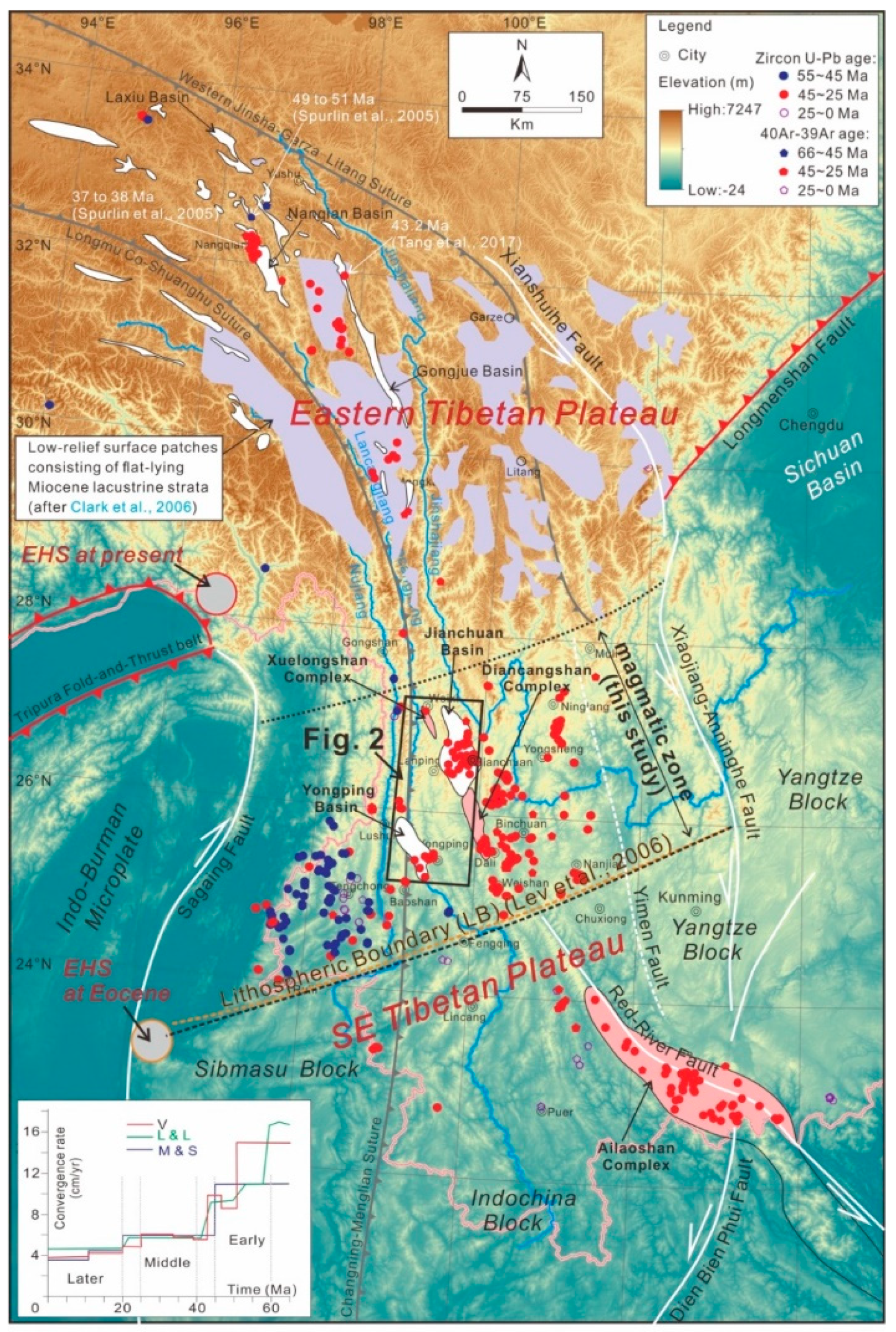

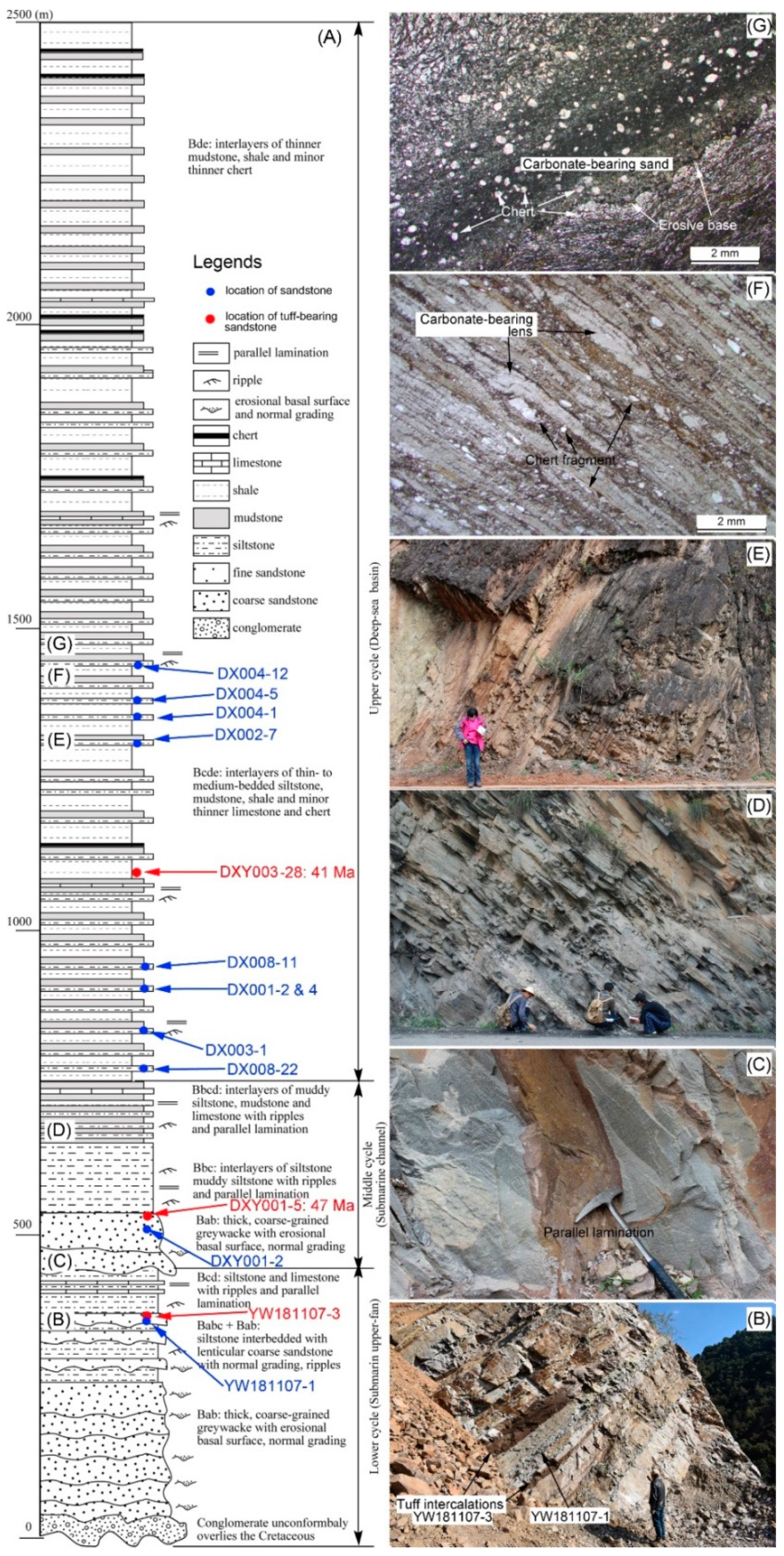
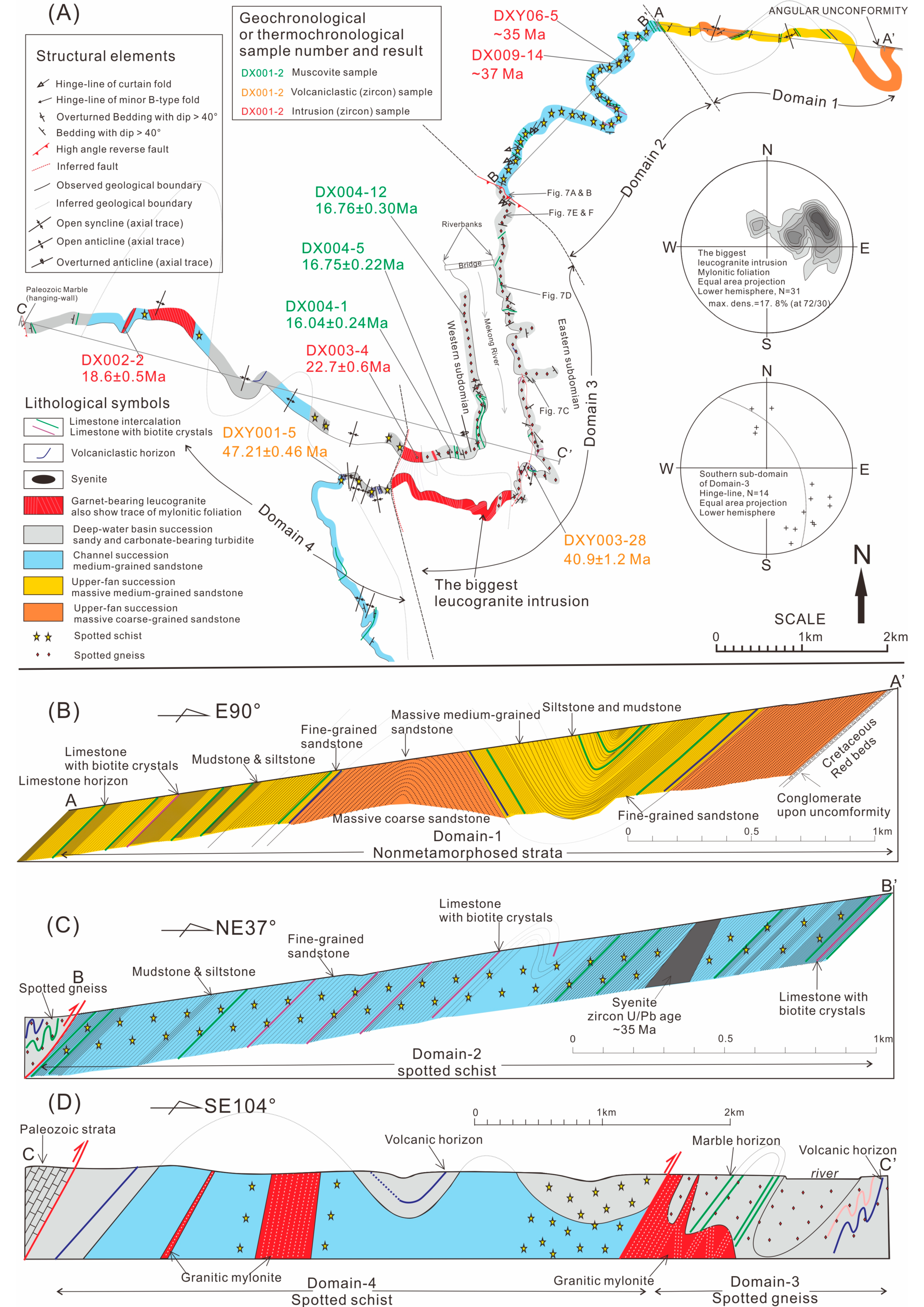
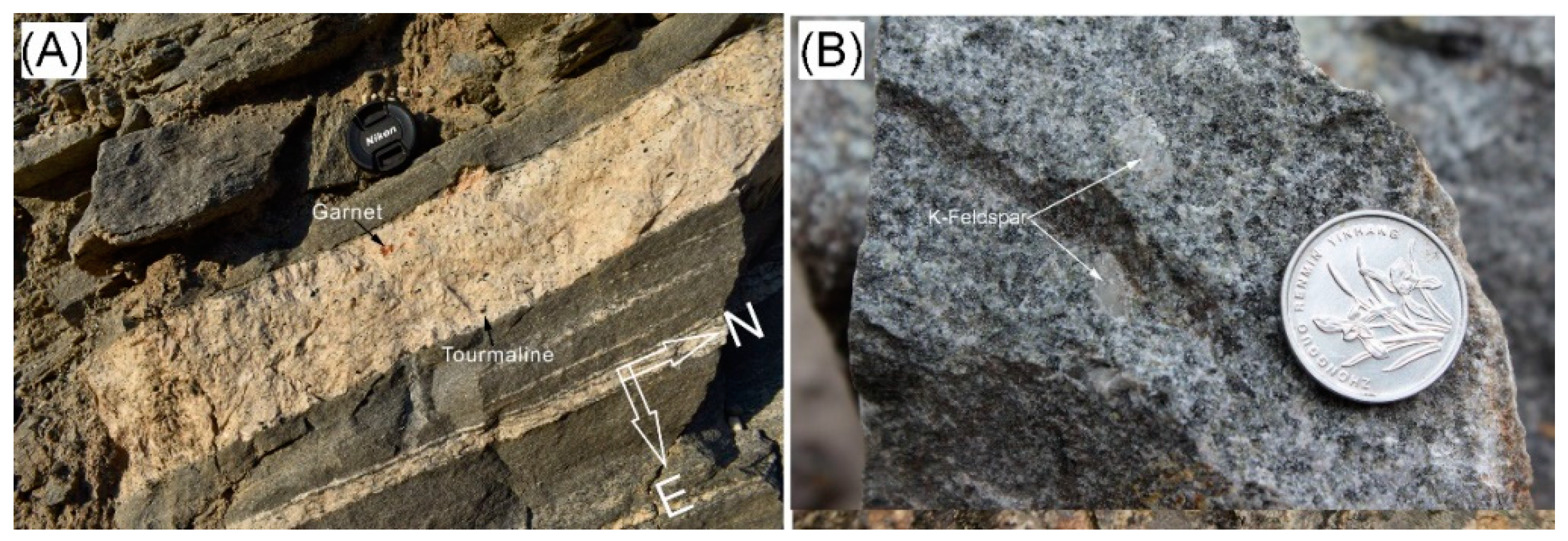
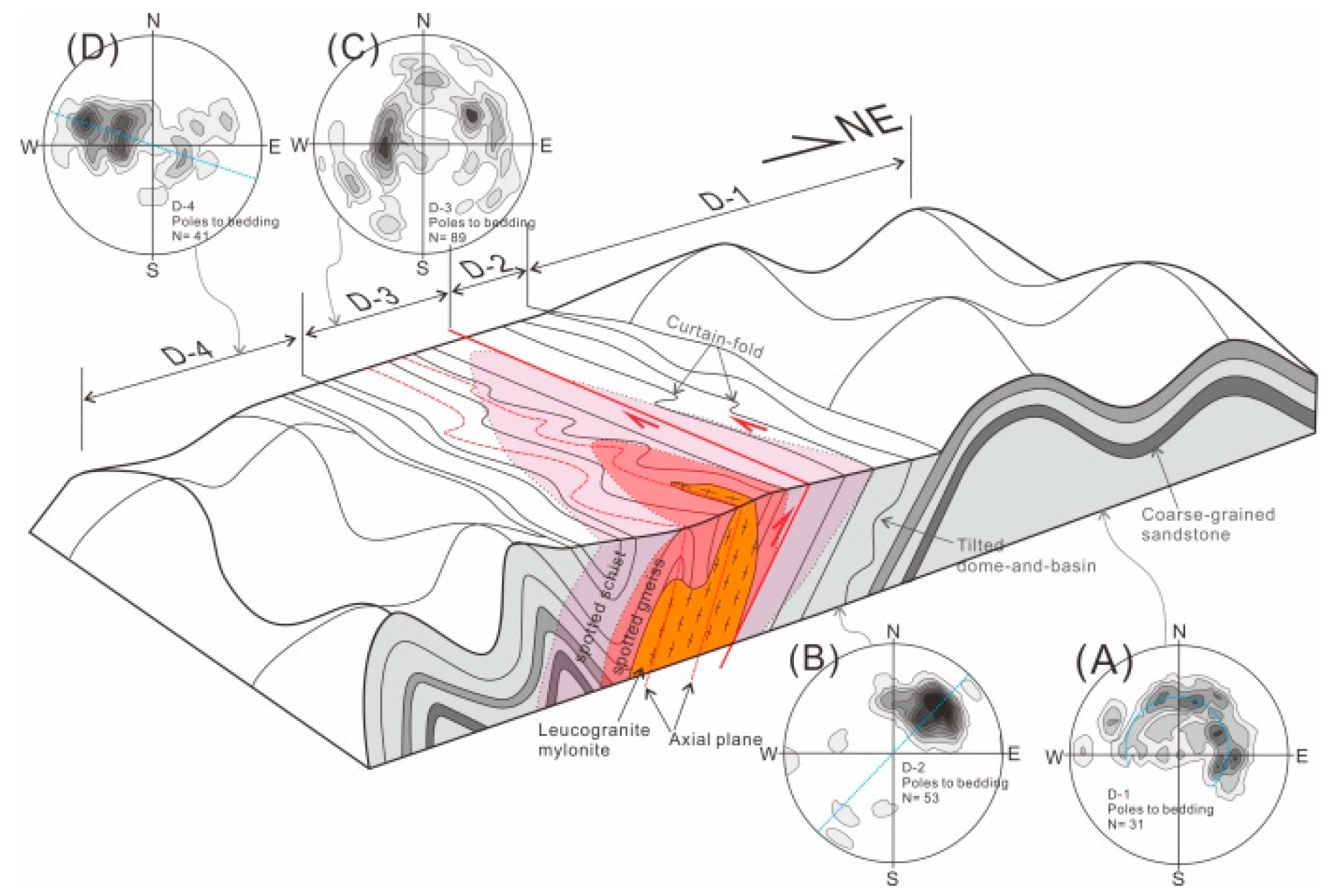
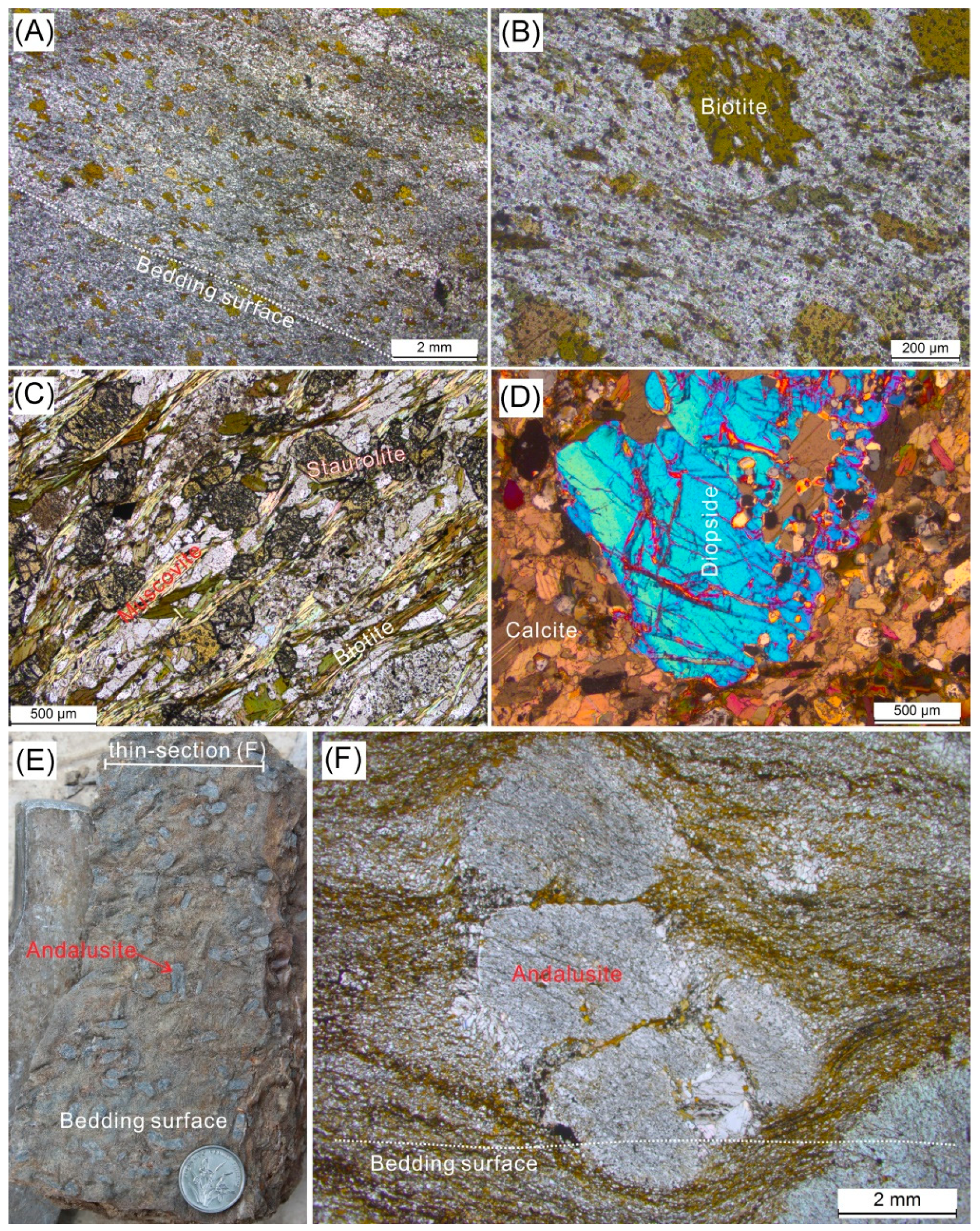
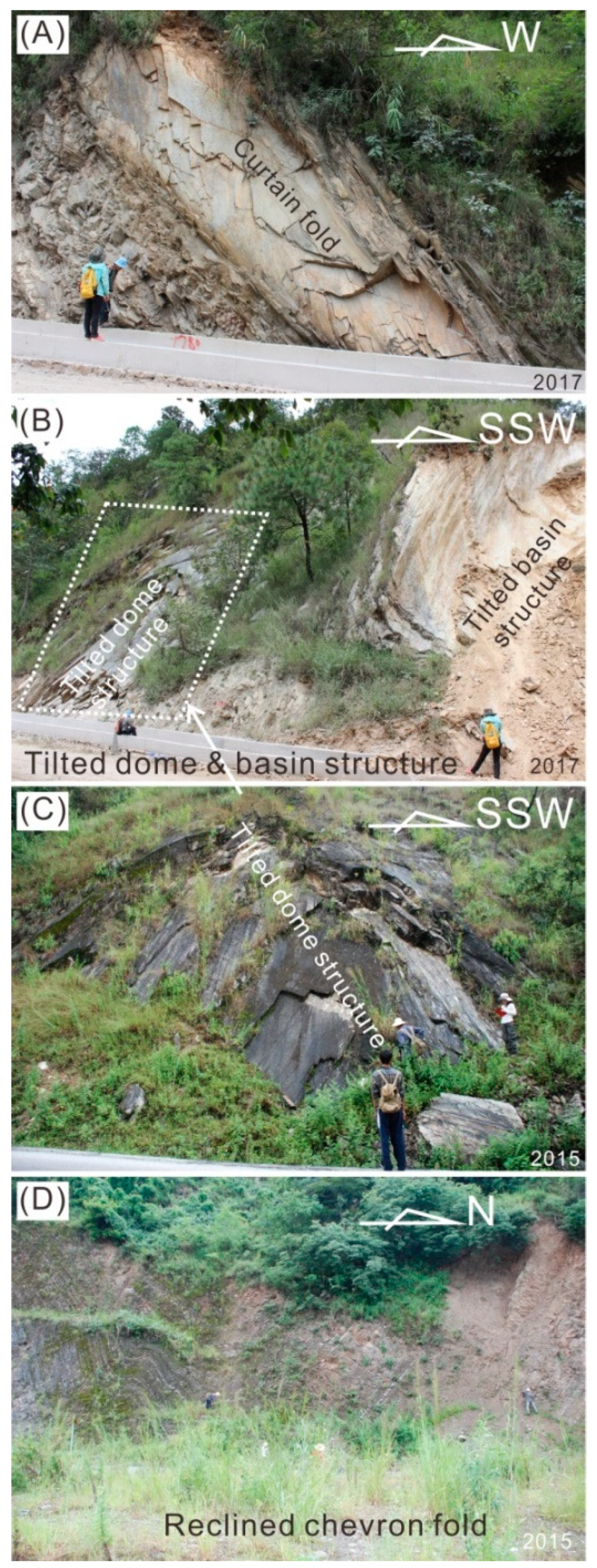

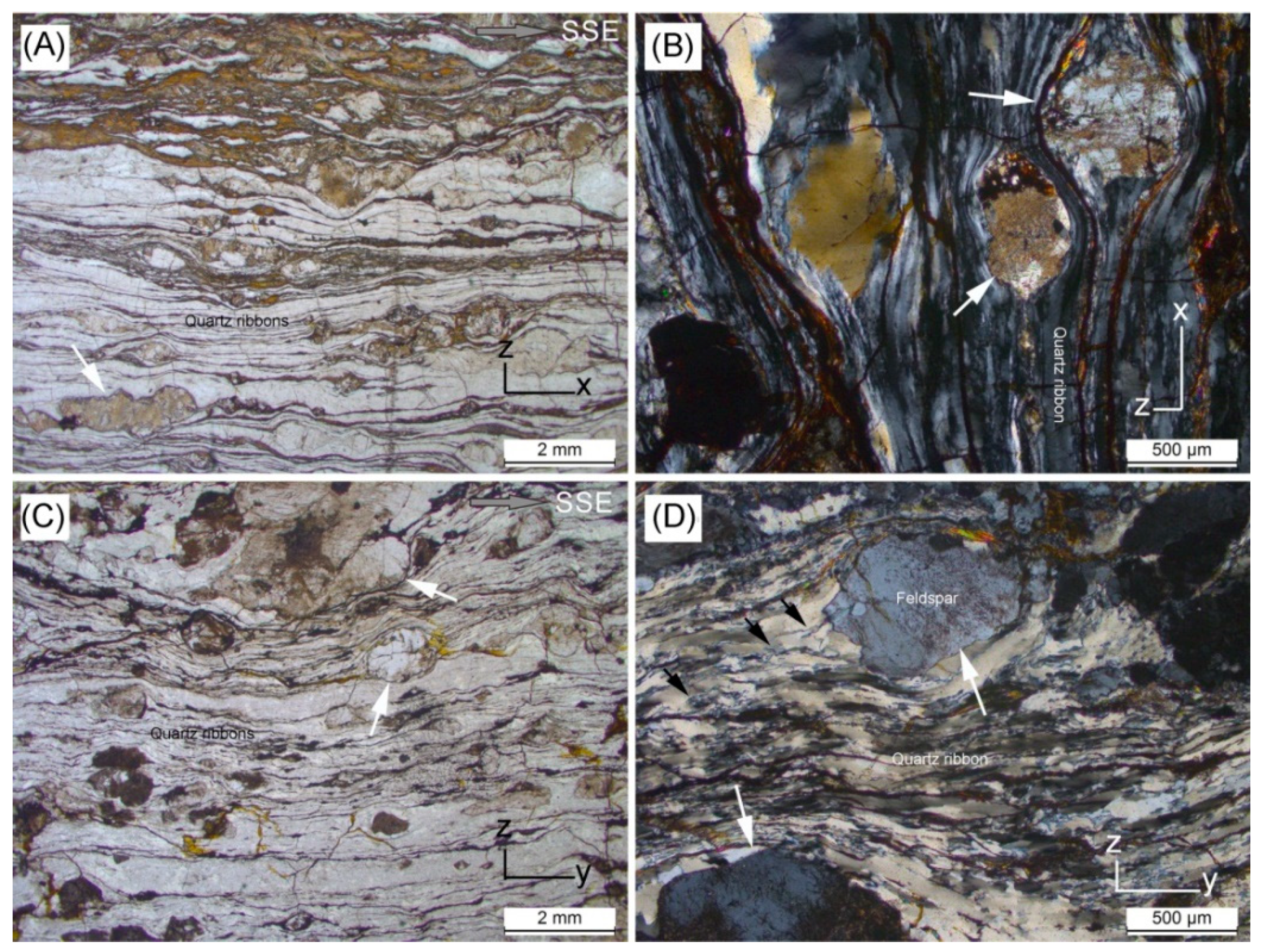
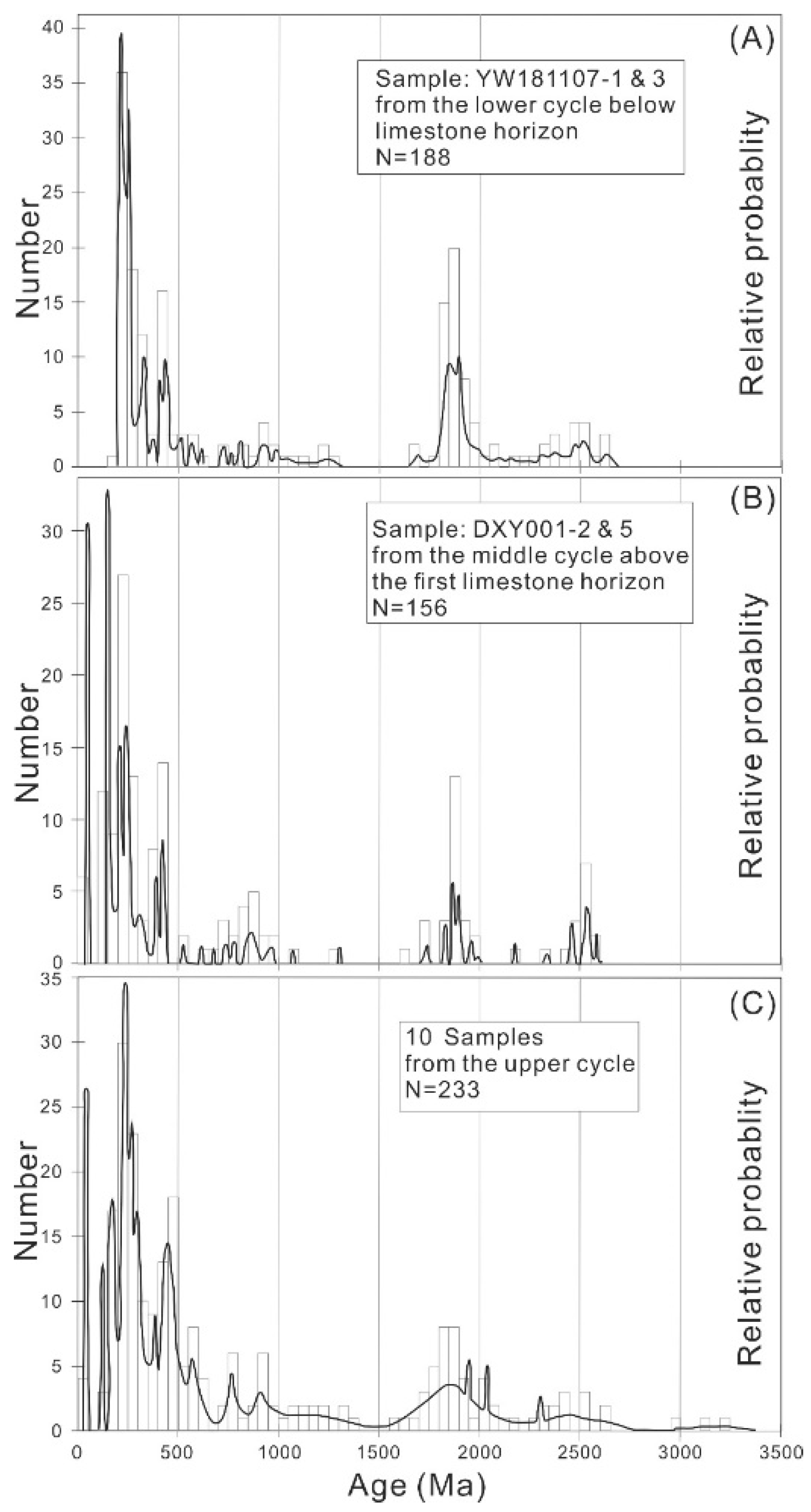
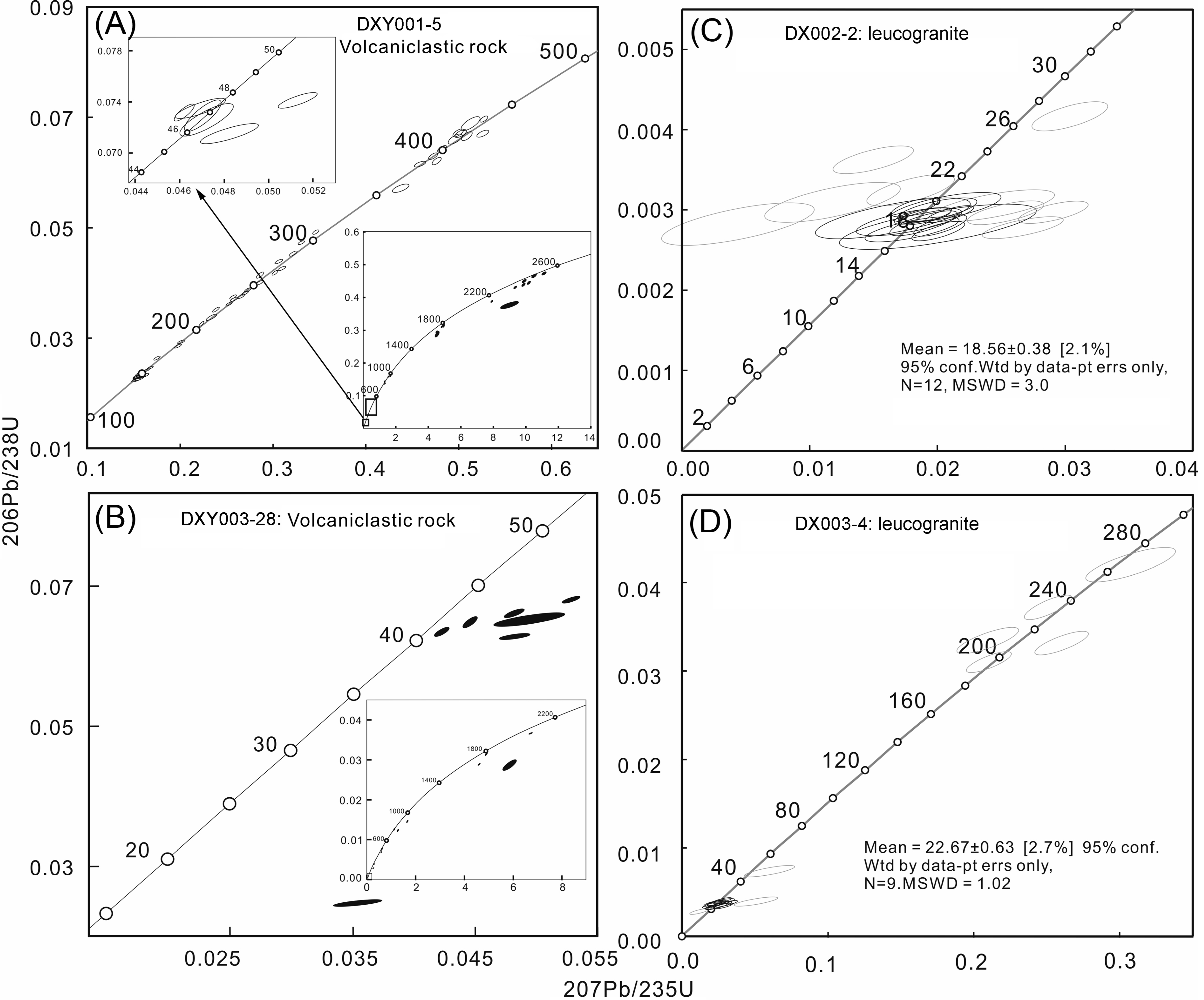
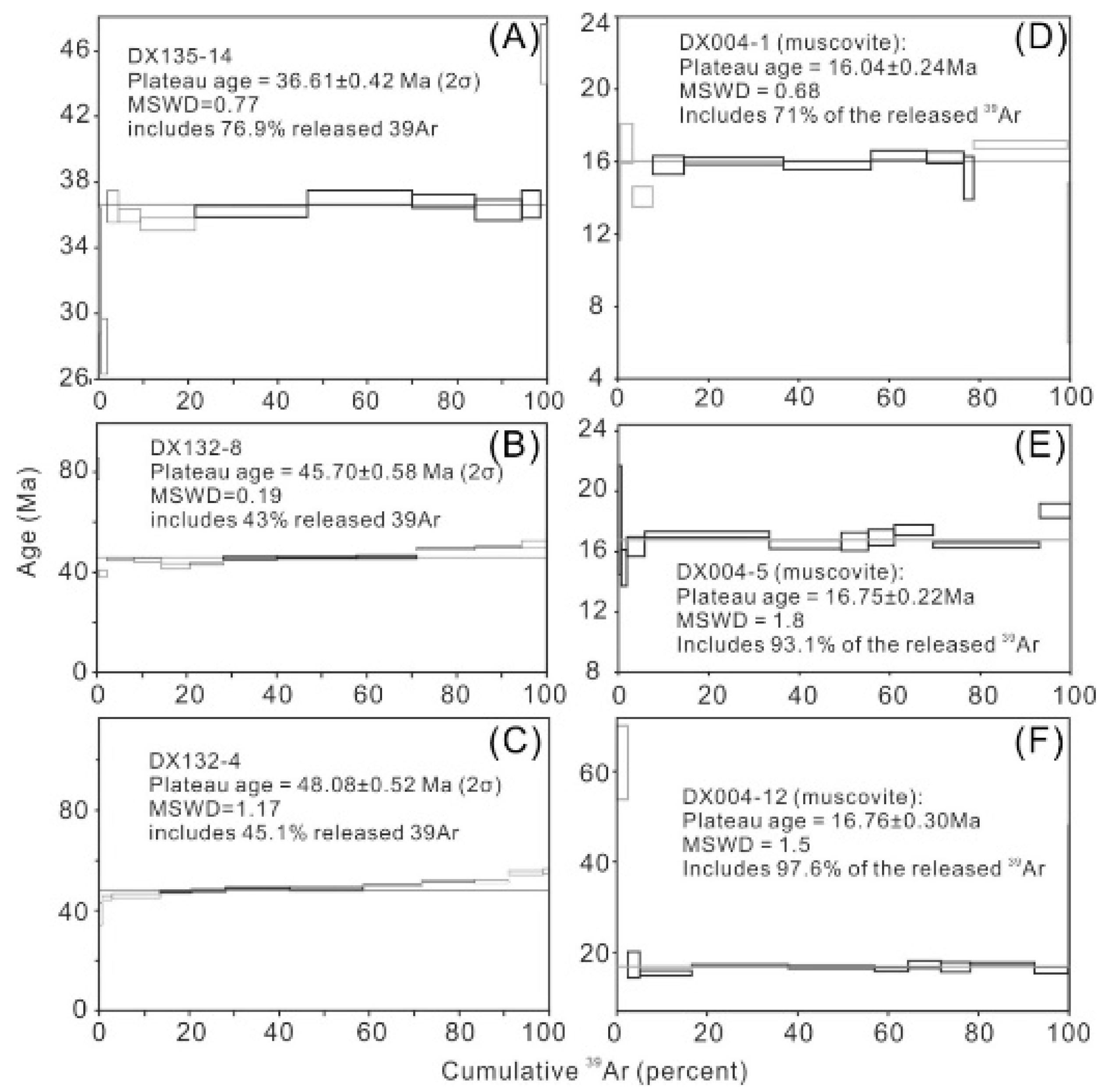
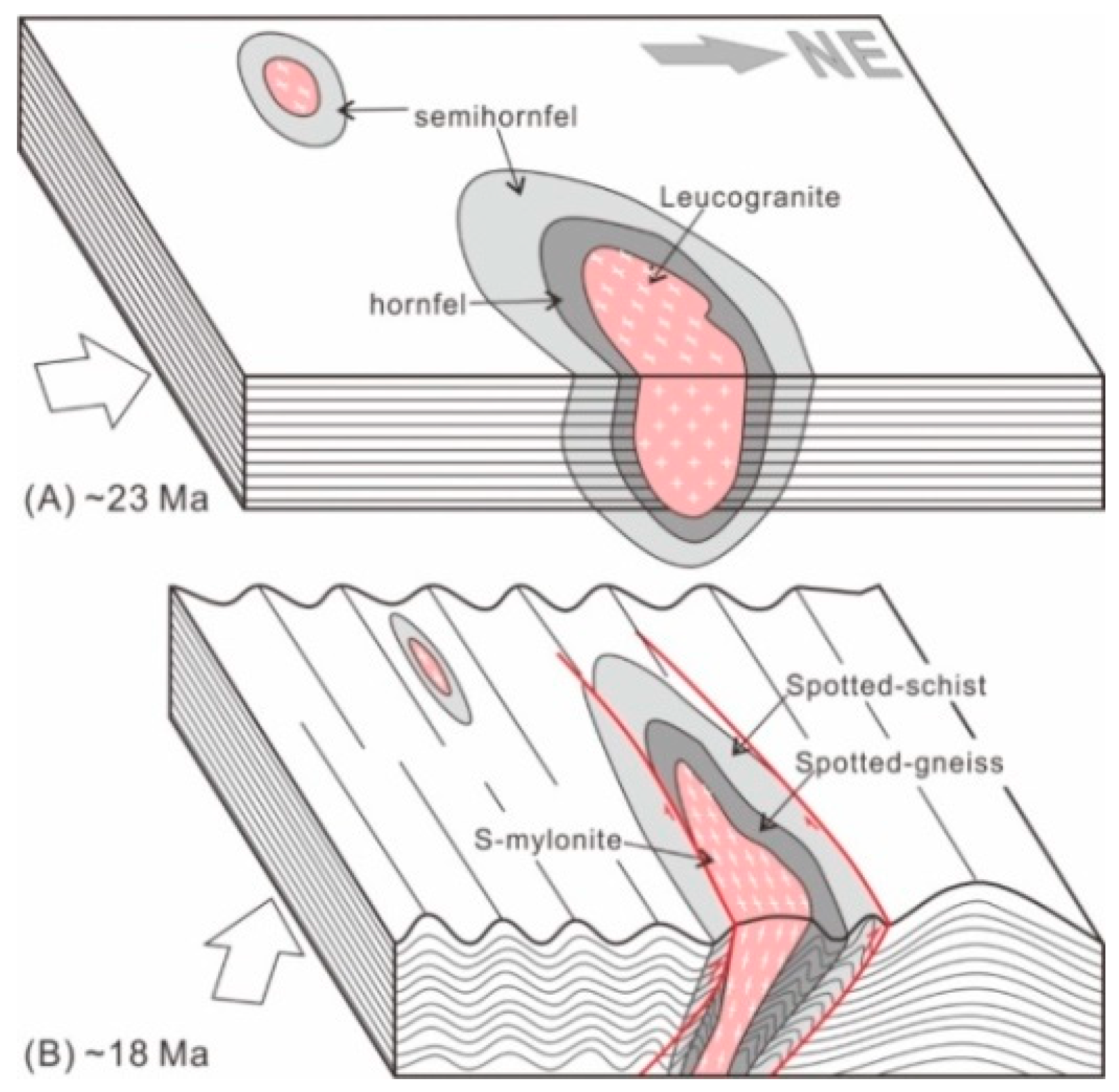
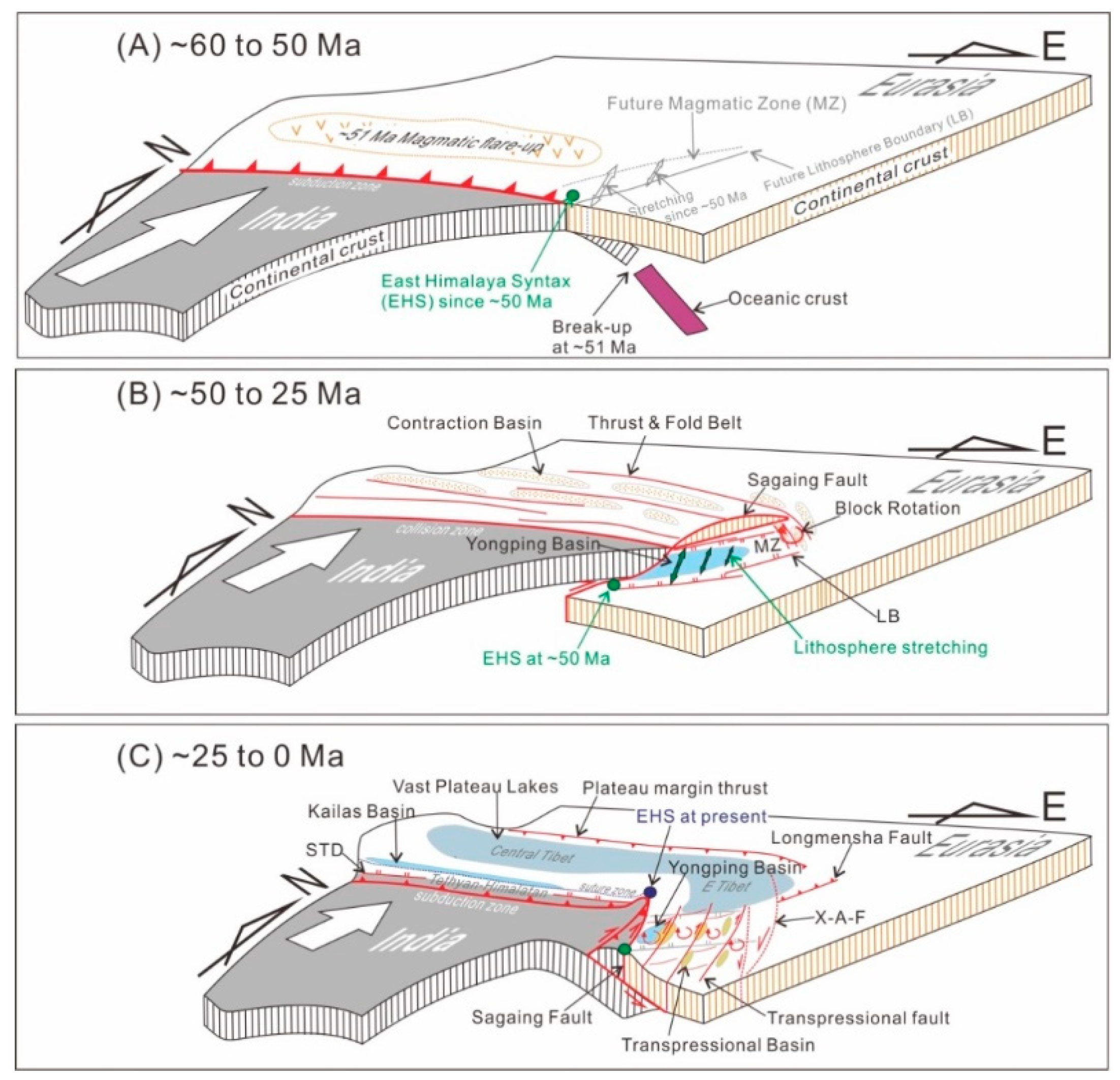
| Sample No. | Lithology | Total Analyses | Concordant Analyses | Weighted Mean Age | GPS Coordination | ||
|---|---|---|---|---|---|---|---|
| Latitude | Longitude | ||||||
| Samples from the Lower Cycle for zircon LA-ICP-MS analyses | |||||||
| 1 | YW181107-1 | sandstone | 120 | 120 | 25°27′37.7″ N | 99°23′28.1″ E | |
| 2 | YW181107-3 | volcanicalstics | 77 | 74 | Without weighted age | ||
| Samples from the Middle Cycle for zircon LA-ICP-MS analyses | |||||||
| 1 | DXY001-2 | sandstone | 80 | 77 | 25°23′48.7″ N | 99°19′40.8″ E | |
| 2 | DXY001-5 | volcaniclastics | 80 | 79 | 47.21 ± 0.46 (n = 5, MSWD = 1.2) | 25°24′20.4″ N | 99°19′40.5″ E |
| Samples from the Upper Cycle for zircon LA-ICP-MS analyses | |||||||
| 1 | DX001-2 | schist | 38 | 37 | 25°25′40.1″ N | 99°17′32.7″ E | |
| 2 | DX001-4 | 25 | 23 | 25°25′40.1″ N | 99°17′32.8″ E | ||
| 3 | DX002-7 | 32 | 26 | 25°25′10.7″ N | 99°19′38.8″ E | ||
| 4 | DX003-1 | 42 | 23 | 25°24′55.6″ N | 99°19′24.2″ E | ||
| 5 | DXY003-28 | volcaniclastics | 28 | 18 | 40.9 ± 1.2 (n = 3, MSWD = 3.1) | 25°24′43.5″ N | 99°20′51.4″ E |
| 6 | DX004-1 | gneiss | 32 | 23 | 25°24′42.8″ N | 99°20′19.0″ E | |
| 7 | DX004-5 | 34 | 23 | 25°24′42.7″ N | 99°20′19.2″ E | ||
| 8 | DX004-12 | 24 | 19 | 25°25′22.7″ N | 99°20′19.5″ E | ||
| 9 | DX008-11 | 22 | 14 | 25°24′42.4″ N | 99°20′52.1″ E | ||
| 10 | DX008-22 | 28 | 18 | 25°25′34.7″ N | 99°20′39.8″ E | ||
| Plutonic samples for zircon LA-ICP-MS analyses | |||||||
| 1 | DX002-2 | leucogranite | 27 | 16 | 18.56 ± 0.38 (n = 12, MSWD = 3) | 25°25′31.9″ N | 99°18′03.3″ E |
| 2 | DX003-4 | 30 | 13 | 22.67 ± 0.63 (n = 9, MSWD = 1.02) | 25°24′45.5″ N | 99°20′27.8″ E | |
| 3 | DXY006-5 | syenite | 17 | 12 | 35.3 ± 1.5 (n = 4, MSWD = 11.5) | 25°27′18.1″ N | 99°21′22.5″ E |
| 4 | DX009-14 | 13 | 4 | without WMA | 25°27′18.1″ N | 99°21′22.5″ E | |
| Samples for 40Ar/39Ar analyses | |||||||
| 1 | DX004-1 | Gneiss (muscovite) | 16.04 ± 0.24 Ma | 25°24′42.8″ N | 99°20′19.0″ E | ||
| 2 | DX004-5 | 16.75 ± 0.22 Ma, | 25°24′42.7″ N | 99°20′19.2″ E | |||
| 3 | DX004-12 | 16.76 ± 0.30 Ma | 25°25′22.7″ N | 99°20′19.5″ E | |||
| 4 | DX132-4 | Lamprophyre (biotite) | 48.08 ± 0.52 Ma | 27°21′06.1″ N | 99°07′33.9″ E | ||
| 5 | DX132-8 | 45.70 ± 0.58 Ma | 27°21′06.1″ N | 99°07′33.9″ E | |||
| 6 | DX135-14 | 36.61 ± 0.42 Ma | 27°21′06.0″ N | 99°07′34.0″ E | |||
Publisher’s Note: MDPI stays neutral with regard to jurisdictional claims in published maps and institutional affiliations. |
© 2021 by the authors. Licensee MDPI, Basel, Switzerland. This article is an open access article distributed under the terms and conditions of the Creative Commons Attribution (CC BY) license (https://creativecommons.org/licenses/by/4.0/).
Share and Cite
Yang, T.; Yan, Z.; Xue, C.; Xin, D.; Dong, M. India Indenting Eurasia: A Brief Review and New Data from the Yongping Basin on the SE Tibetan Plateau. Geosciences 2021, 11, 518. https://doi.org/10.3390/geosciences11120518
Yang T, Yan Z, Xue C, Xin D, Dong M. India Indenting Eurasia: A Brief Review and New Data from the Yongping Basin on the SE Tibetan Plateau. Geosciences. 2021; 11(12):518. https://doi.org/10.3390/geosciences11120518
Chicago/Turabian StyleYang, Tiannan, Zhen Yan, Chuandong Xue, Di Xin, and Mengmeng Dong. 2021. "India Indenting Eurasia: A Brief Review and New Data from the Yongping Basin on the SE Tibetan Plateau" Geosciences 11, no. 12: 518. https://doi.org/10.3390/geosciences11120518
APA StyleYang, T., Yan, Z., Xue, C., Xin, D., & Dong, M. (2021). India Indenting Eurasia: A Brief Review and New Data from the Yongping Basin on the SE Tibetan Plateau. Geosciences, 11(12), 518. https://doi.org/10.3390/geosciences11120518






